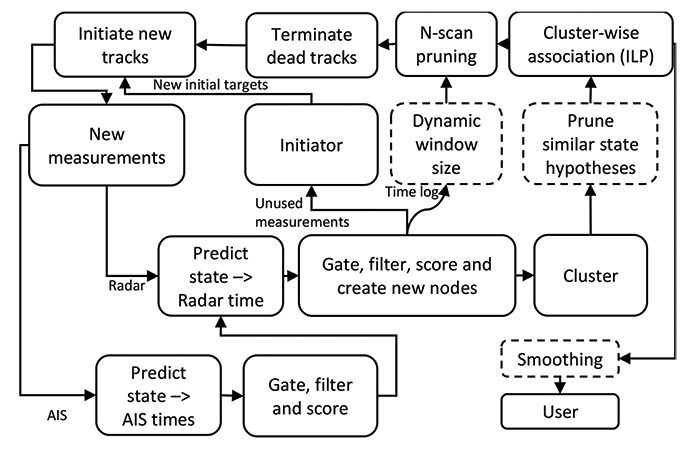All vessels of a certain size are required to be connected to the Automatic Identification System (AIS). AIS equipment on board the ship transmits its unique ID tag, position and velocity to nearby vehicles. Together with maritime radar, AIS is therefore a key technology in collision maritime avoidance.
AIS do not suffer from many of the weaknesses of radar data such as misdetections and false alarms. However, AIS has its own weaknesses (limited update rate, possibly wrong ID tags) and many small boats as well as rogue vessels do not use AIS. A key objective of the Autosea project is to develop a sensor fusion system that combines radar and AIS so that the strengths of both systems can be expoited, while the weaknesses can be mitigated as much as possible.
During the Spring 2017, a master thesis on fusion of AIS and radar using multiple hypothesis tracking (MHT) was written. This thesis may be used as a starting point for this project.

Proposed Tasks:
For the proposed assignment, the goal is to integrate radar-AIS fusion in the Poisson Multi-Bernoulli Mixture (PMBM) filter, which recently has been emerging as a gold standard in multi-target tracking.
- Make yourself familiar with the concepts of AIS, measurement-level fusion, track-level fusion and MHT, and summarize the findings in the report.
- Derive mathematical models for fusion of radar measurements and AIS. The references below provide possible starting points.
- Integrate the models in the PMBM filter.
- Develop suitable mixture reduction techniques, aiming to utilize the information from the two information sources optimally.
- If time, experiment with typical flaws in AIS data (biases, GPS outages, label swapping) both in the simulations and in the method.
- Describe the findings in your report.
This project goes to the core of central issues in multi-sensor fusion. Very similar problems arise in a variety of other contexts, such as fusion between radar and cooperative drone trackers, which is important in air traffic surveillance (see e.g. https://www.unifly.aero/class). To succeed with this project you should be comfortable working with things such as probability densities, covariances and data structures.
Supervisors
Main supervisor: Edmund F. Brekke
Prerequisites
This is a list of recommended prerequisites for this master project.
- Strong programming skills in either Matlab, Python or C++. You should have written several programs in the size of 1000’s of code lines.
- Significant exposure to statistics and algorithms, ideally through additional courses from IMF/IDI or foreign universities such as ETH or UCSB.
- Experience with sensor fusion or radar systems from internships or voluntary activities.
References
- Liland (2007): “AIS Aided Multi Hypothesis Tracker”, Master’s thesis, NTNU.
- Habtemariam et al. (2014): “Measurement levelAIS/radar fusion”, Signal Processing.
- Bar-Shalom & Chen (2006): “Multisensor Track-to-Track Association for Tracks with Dependent Errors”, Journal of Advances in Information Fusion.
- Williams (2015): “Marginal multi-bernoulli filters: RFS derivation of MHT, JIPDA, and association-based member”, IEEE-TAES